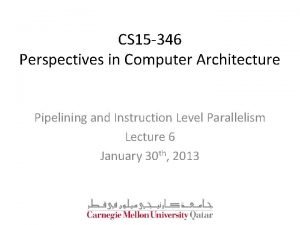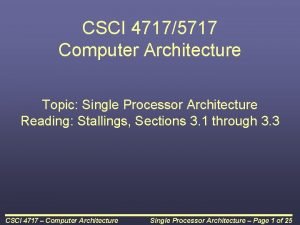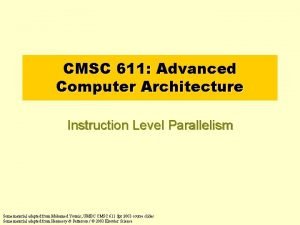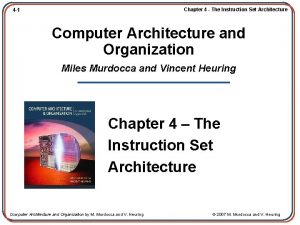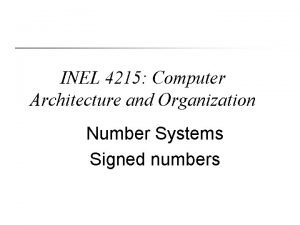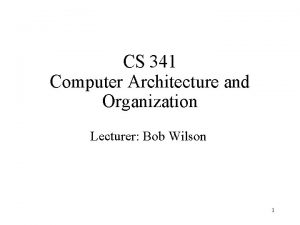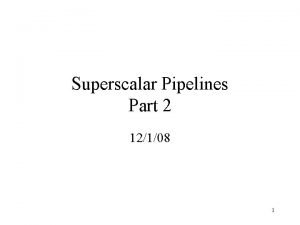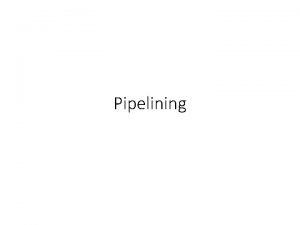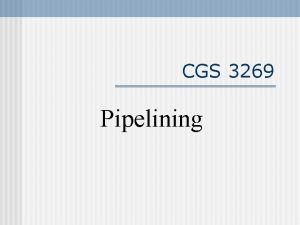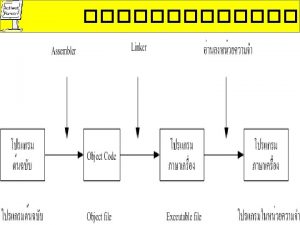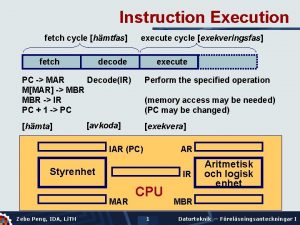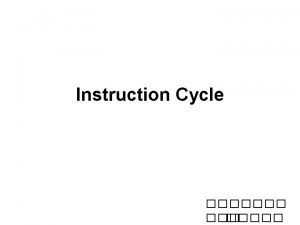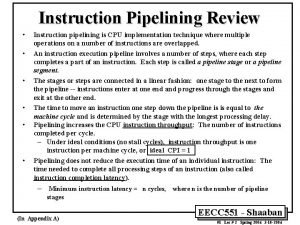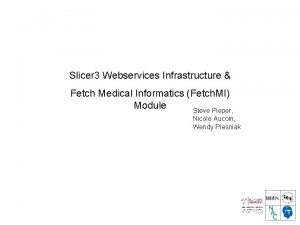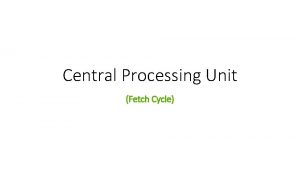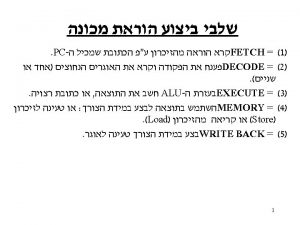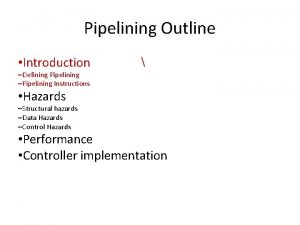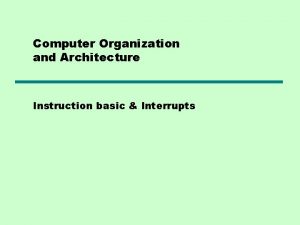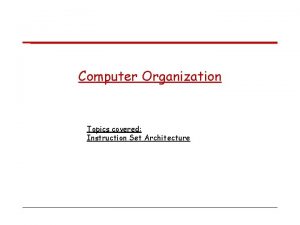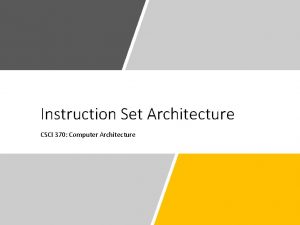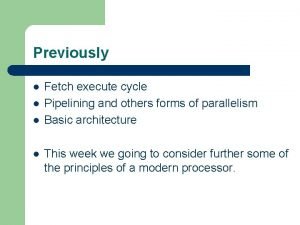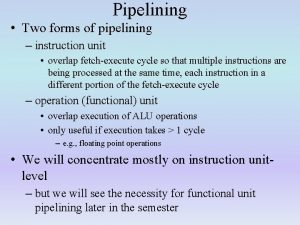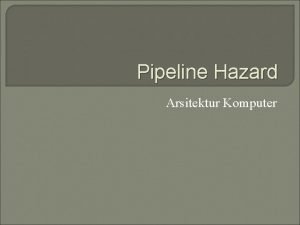Computer Organization and Architecture Instruction Pipelining Pipelining Fetch





























- Slides: 29

Computer Organization and Architecture Instruction Pipelining

Pipelining • • • Fetch instruction Decode instruction Calculate operands (i. e. EAs) Fetch operands Execute instructions Write result • Overlap these operations

Two Stage Instruction Pipeline

Timing Diagram for Instruction Pipeline Operation

The Effect of a Conditional Branch on Instruction Pipeline Operation

Six Stage Instruction Pipeline

Alternative Pipeline Depiction

Pipeline Performance • The cycle time of an instruction pipeline is the time needed to advance a set of instructions one stage through the pipeline • The cycle time can be determined as

Pipeline Performance(2) • Now suppose that n instructions are processed, with no branches. Let be the total time required for a pipeline with k stages to execute n instructions. Then • The speedup factor for the instruction pipeline compared to execution without the pipeline is defined as

Speedup Factors with Instruction Pipelining

Pipeline Hazards • Pipeline, or some portion of pipeline, must stall • Also called pipeline bubble • Types of hazards —Resource —Data —Control

Resource Hazards • • Two (or more) instructions in pipeline need same resource Executed in serial rather than parallel for part of pipeline Also called structural hazard E. g. Assume simplified five-stage pipeline — Each stage takes one clock cycle • Ideal case is new instruction enters pipeline each clock cycle • Assume main memory has single port • Assume instruction fetches and data reads and writes performed one at a time • Ignore the cache • Operand read or write cannot be performed in parallel with instruction fetch • Fetch instruction stage must idle for one cycle fetching I 3 • E. g. multiple instructions ready to enter execute instruction phase • Single ALU • One solution: increase available resources — Multiple main memory ports — Multiple ALUs

Resource Hazard Diagram

Data Hazards • • • Conflict in access of an operand location Two instructions to be executed in sequence Both access a particular memory or register operand If in strict sequence, no problem occurs If in a pipeline, operand value could be updated so as to produce different result from strict sequential execution • E. g. x 86 machine instruction sequence: • ADD EAX, EBX • SUB ECX, EAX /* EAX = EAX + EBX /* ECX = ECX – EAX • ADD instruction does not update EAX until end of stage 5, at clock cycle 5 • SUB instruction needs value at beginning of its stage 2, at clock cycle 4 • Pipeline must stall for two clocks cycles • Without special hardware and specific avoidance algorithms, results in inefficient pipeline usage

Data Hazard Diagram

Types of Data Hazard • Read after write (RAW), or true dependency — An instruction modifies a register or memory location — Succeeding instruction reads data in that location — Hazard if read takes place before write complete • Write after read (WAR), or antidependency — An instruction reads a register or memory location — Succeeding instruction writes to location — Hazard if write completes before read takes place • Write after write (WAW), or output dependency — Two instructions both write to same location — Hazard if writes take place in reverse of order intended sequence • Previous example is RAW hazard

Write After Read (WAR) • (i 2 tries to write a destination before it is read by i 1) A write after read (WAR) data hazard represents a problem with concurrent execution. • Example • For example: • i 1. R 4 <- R 1 + R 3 i 2. R 3 <- R 1 + R 2 • If we are in a situation that there is a chance that i 2 may be completed before i 1 (i. e. with concurrent execution) we must ensure that we do not store the result of R 3 before i 1 has had a chance to fetch the operands.

Write After Write (WAW) • (i 2 tries to write an operand before it is written by i 1) A write after write (WAW) data hazard may occur in a concurrent execution environment. • Example • For example: • i 1. R 2 <- R 4 + R 7 i 2. R 2 <- R 1 + R 2 • We must delay the WB (Write Back) of i 2 until the execution of i 1.

Control Hazard • Also known as branch hazard • Pipeline makes wrong decision on branch prediction • Brings instructions into pipeline that must subsequently be discarded • Dealing with Branches —Multiple Streams —Prefetch Branch Target —Loop buffer —Branch prediction —Delayed branching

Multiple Streams • Have two pipelines • Prefetch each branch into a separate pipeline • Use appropriate pipeline • Leads to bus & register contention • Multiple branches lead to further pipelines being needed

Prefetch Branch Target • Target of branch is prefetched in addition to instructions following branch • Keep target until branch is executed • Used by IBM 360/91

Loop Buffer • • • Very fast memory Maintained by fetch stage of pipeline Check buffer before fetching from memory Very good for small loops or jumps c. f. cache Used by CRAY-1

Loop Buffer Diagram

Branch Prediction (1) • Predict never taken —Assume that jump will not happen —Always fetch next instruction — 68020 & VAX 11/780 —VAX will not prefetch after branch if a page fault would result (O/S v CPU design) • Predict always taken —Assume that jump will happen —Always fetch target instruction

Branch Prediction (2) • Predict by Opcode —Some instructions are more likely to result in a jump than thers —Can get up to 75% success • Taken/Not taken switch —Based on previous history —Good for loops —Refined by two-level or correlation-based branch history • Correlation-based —In loop-closing branches, history is good predictor —In more complex structures, branch direction correlates with that of related branches – Use recent branch history as well

Branch Prediction (3) • Delayed Branch —Do not take jump until you have to —Rearrange instructions

Branch Prediction Flowchart

Branch Prediction State Diagram

Dealing With Branches
 Pipelining in computer architecture examples
Pipelining in computer architecture examples Instruction set architecture in computer organization
Instruction set architecture in computer organization Linear and nonlinear pipeline
Linear and nonlinear pipeline Diff between computer architecture and organization
Diff between computer architecture and organization Instruction format in computer architecture
Instruction format in computer architecture State diagram in computer architecture
State diagram in computer architecture Ilp computer architecture
Ilp computer architecture Instruction format in computer architecture
Instruction format in computer architecture Computer organization and architecture 10th solution
Computer organization and architecture 10th solution Coa virtual lab iit kharagpur
Coa virtual lab iit kharagpur Introduction to computer organization and architecture
Introduction to computer organization and architecture Spec rating formula in computer organization
Spec rating formula in computer organization Computer organization and architecture 10th edition
Computer organization and architecture 10th edition William stallings computer organization and architecture
William stallings computer organization and architecture Computer organisation and architecture
Computer organisation and architecture 1s complement
1s complement Computer architecture and organization
Computer architecture and organization Process organization in computer organization
Process organization in computer organization Buses in computer architecture
Buses in computer architecture Memory organization in computer architecture
Memory organization in computer architecture Basic structure of computer system
Basic structure of computer system Basic computer design
Basic computer design Flow chart for interrupt cycle
Flow chart for interrupt cycle Differentiated instruction vs individualized instruction
Differentiated instruction vs individualized instruction What is direct instruction strategy
What is direct instruction strategy Point-by-point comparison
Point-by-point comparison Pipelining and superscalar techniques
Pipelining and superscalar techniques Scalar pipeline vs superscalar pipeline
Scalar pipeline vs superscalar pipeline Skipcond
Skipcond Instruction set architectures
Instruction set architectures
